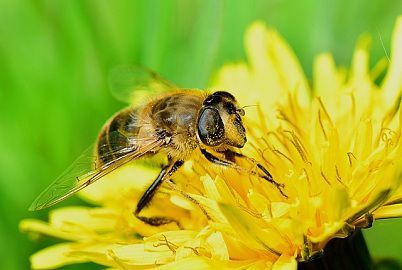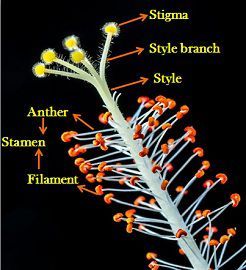Pollination is a process of transferring of pollens from one flower to another. While fertilization is the process after the successful transfer of pollination, which involves the fusion of male gametes and female gametes of plants. Both of these are the natural process. But only flowering plants undergo the process of pollination, while fertilization is the common process of almost all living being.
Continuation of life would not have been possible without the presence of plants, as directly or indirectly every organism depends on them. Like the various other organisms which reproduce sexually, the same way flowering plants also do. To forward their characters to other generation and to increase their population size, the plants mainly reproduces in two ways- Pollination and Fertilization.
In this process, flowering plants reproduce by combining egg cells and sperm cells, to form a zygote. This zygote matures into the seeds and grows the next generation. Female egg cells are present in the ovary while male sperm is present in the pollen grains.
In this article, we will be going through the important points which distinguish these two processes along with some more additional information on them.
Content: Pollination Vs Fertilization
Comparison Chart
| Basis for Comparison | Pollination | Fertilization |
|---|---|---|
| Meaning | The process of transfer of pollen from the male parts (anther) of a flower to the female part (stigma) of the same or different flower is called as pollination. | Whereas the fertilization is the common process, involving the union of the male gamete (sperm) and female gamete (egg). |
| Pollen tube | No formation of the pollen tube. | Formation of pollen tube which helps in transferring of male gametes up to an egg cell. |
| Kind of mechanism | It is an external mechanism and takes place on the outer part of a flower. | It is an internal mechanism and takes place inside the flowers. |
| Time of process | Pollination takes place before fertilization. | Fertilization takes place after pollination. |
| Type | Two types: Self-pollination. Cross-pollination. | No types. |
| It occurs in | Pollination occurs in flowering plants only. | Fertilization is followed by almost every plant and living being present on earth. |
| External Factors | Required pollination agent (external factors). | No external factors. |
Definition of Pollination
Pollination is the germination of pollen on the stigma. It is the process of transferring of pollens from the male organ to the female organ of the same or different flower.
The male organ, anther produces the pollen grains containing the male genetic material. Anthers are located at the tip of a stalk known as a stamen.
Stigma is the organ containing the female part, which receives the pollen grains. This is present at the tip of the female organ called as pistil. This will help in sending the sperm cell from the stigma to the ovary which contains the eggs or ovules.
Pollination occurs within a flower (self-fertilization), or it can ground on a different flower on the same or different plant. Nearly 25% of these plant produces two different flowers- staminate and pistillate flowers, on the same flowers.
An example of this kind is maize plant, which has staminate and pistillate flowers on the same plant. Such kind of species is called as monoecious.
Although the remaining 4% of species produces, staminate and pistillate flowers on separate plants, so these are considered to be dioecious (two houses). Pollination can be of two types: Self-pollination and Cross-pollination.
Self-pollination – The stigma (female part ) receives the pollen from the flower of the same plant. It is commonly seen in Arabidopsis thaliana, Capsella rubella, Bulbophyllum bicoloratum. This is also of two types: autogamy and geitonogamy.
In autogamy, pollen is transferred from the same flowers to the stigma, while in the geitonogamy, pollen gets transferred from one flower to the another of the same flowering plants.
Cross pollination – The stigma receives the pollen from the another plant of same species. This method is commonly used in increasing the variety of the plants, especially vegetables, fruits and flowering plants.
Transfer of pollens from the anther to the stigma by various agents such as insects, butterflies, moths, etc. Other agents are winds, birds, and animals. The process of pollination was discovered by Christian Sprengel in the 18th century.
Definition of Fertilization
In the process of fertilization, there is a union of sperm and egg; it is the mechanism after pollination. Each sperm and egg contain half of their hereditary material, which further unite to develop a new plant.
When the pollen grain come in contact with the stigma, a tiny tube is generated along with the sperm. This tube gets fit into another pipe like structure called as the style of the female pistil.
This tube further expands from the style to the opening of the ovary, where the sperms get collected. When these sperm and egg get fuse completely, the egg fertilizes and develop into a plant seed (zygote). The process of fertilization occurs deep inside the flowering plants.
Double fertilization – This is the very distinct process, pursued by the angiosperm plants. In this process out of two sperms, one sperm fertilizes the egg to form the zygote (syngamy). While the other sperm combines with the secondary nucleus (triple fusion) to form a triploid nucleus (3n). This is also called as primary endosperm nucleus.
Hence the fusion of the two male gametes with different nuclei of the embryo sac is called as double fertilization. The fertilized egg fuse to become the zygote, which develops into an embryo.
Key Differences Between Pollination and Fertilization
Given below are the substantial key differences between the two important process of reproduction:
- The process of transfer of pollen from the male parts (anther) of a flower to the female part (stigma) of the same or different flower is called as pollination. Whereas the fertilization is the common process, involving the union of the male gamete (sperm) and female gamete (egg).
- Pollination does not involve the formation of the pollen tube, while in fertilization there is the formation of pollen tube which helps in transferring of male gametes up to an egg cell.
- Pollination is an external mechanism and takes place on an outer part of a flower, while fertilization is an internal mechanism and takes place inside the flowers.
- Pollination takes place before fertilization, and it is of two types – self-pollination and cross-pollination. Fertilization takes place only after pollination.
- Pollination occurs in flowering plants only, and fertilization is followed by almost every living plants and living being present on earth.
- Pollination requires pollinating agent like wind, insects, animals, etc., whereas in fertilization there is no such requirement apart from the male gamete (sperms) and female gamete (egg).
Conclusion
So we can say that flowering plants reproduce through two ways – pollination and fertilization. The former one is followed by few plants, while the latter is the very common procedure and thus followed by almost every plant, in fact, every living organism present on this earth.
Pollination is the simple process of transferring the pollens to the stigma of plants, though this procedure is of different types. In general, fertilization involves the joining of male gametes (sperms) with that of the female gamete (egg), which results in the formation of zygote. It is the common process which is followed by not only plants but also by animals and other living beings.



Deepal says
excellent work.
GL1449 says
Very explanatory thanks❤❤